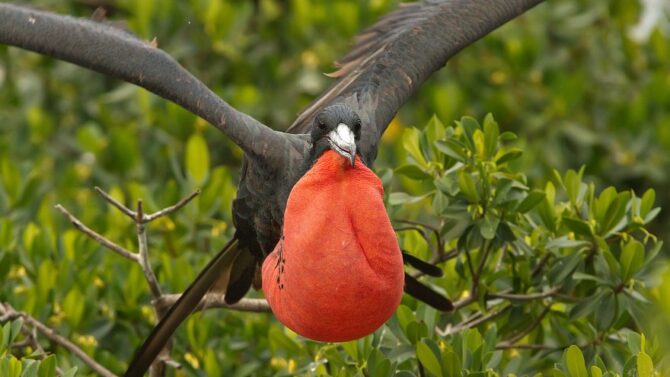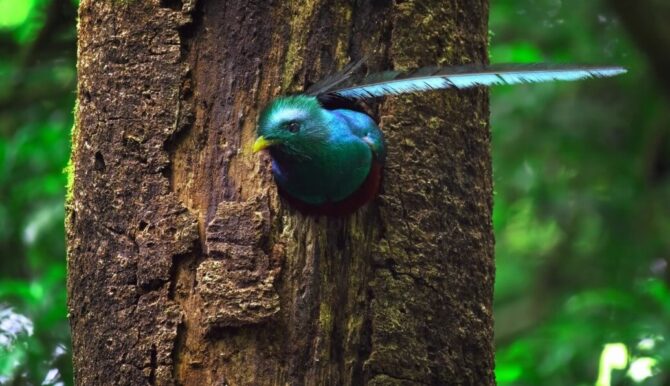Birds, the explorers of the skies, are a wonder to man. Of the multiple species that exist, each graces the skies and adorns nature with its immaculate looks, innovatory exploits, and for some, strange and odd looks.
While weird birds may not be particularly an exciting hallmark of the aves species, it certainly catches our wonder.
These strange-looking birds, which include the helmeted hornbill, California condor, Papuan frogmouth, and much more, catch the gaze of those fortunate enough to sight them, whether in fear or wonderment.
But for many who are oblivious to these species, we hope to bring enlightenment to the world’s strangest, most bizarre-looking, and weirdest birds with pictures, facts, and how to identify them.
Weird Birds: The Strangest & Weird-looking Species
1. Kakapo
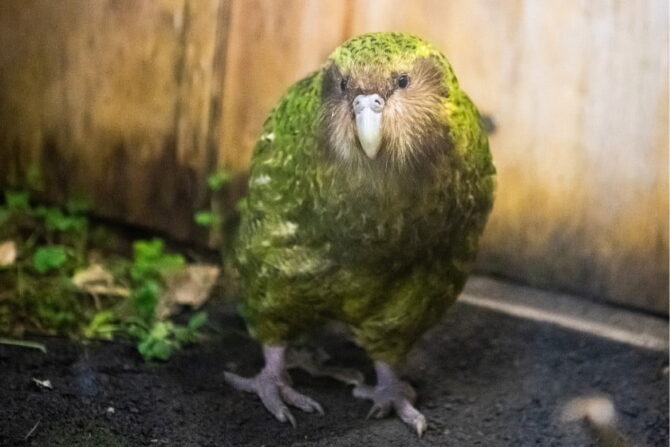
- Scientific name: Strigops habroptilus
- Length: 25 inches
- Weight: 2kg – 4kg (Male, Adult)
- Wingspan: A few feet
- Identifying Features: Flightless, heaviest of all parrots, nocturnal, relatively short wings, upper parts have yellowish moss-green feathers barred or mottled with black or dark brownish grey. The belly, undertail, neck, and face are predominately yellowish streaked.
- Where found: New Zealand
- Conservation Status: Endangered
These birds’ unique, weird features are that they are fat, flightless, and nocturnal.
The kakapo sniffs out food with its well-adapted olfactory senses but suffers from poor eyesight.
It is a critically endangered flightless parrot native to New Zealand. They are the heaviest of all parrot species.
The kakapo is a yellowish, mossy-green plumage sprinkled with brown and grey; it is often called the “owl parrot” because its feather-light facial disc duplicates an owl.
2. Magnificent Frigatebird
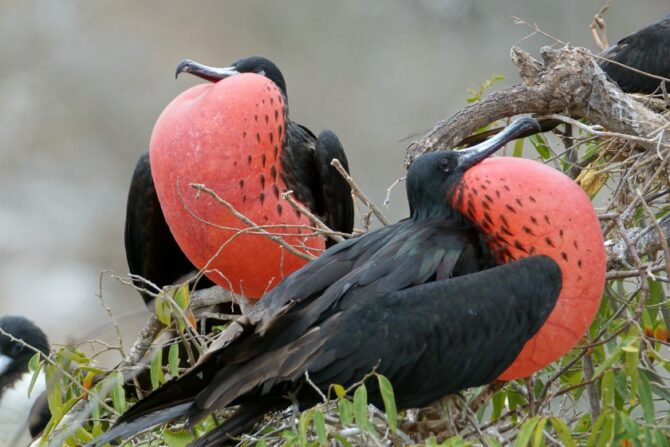
- Scientific name: Fregata magnificens
- Length: 2 feet, 11 inches- 3 feet, 9 inches
- Weight: 1.1kg – 1.59kg
- Wingspan: 7 feet, 1 inch – 8 feet, 0 inch
- Identifying Features: Large slender, mostly black-plumaged seabirds with white markings on their underparts, short necks, and slender hooked bills; tails are deeply forked.
- Where found: Coast Florida and in the tropical Atlantic and Pacific Oceans
- Conservation Status: Least Concern
Frigatebirds come from the family of blackbirds who possess giant beaks and whose males all have gigantic gular pouches.
The magnificent frigatebird made it to this list because it has a giant, bright red gular pouch that takes up a large portion of its body.
But while the birds’ appearance may be bizarre and magnificent, their behavior is not. They have the ability to cause other birds to regorge their food so they may feast on it.
3. Rufous Potoo
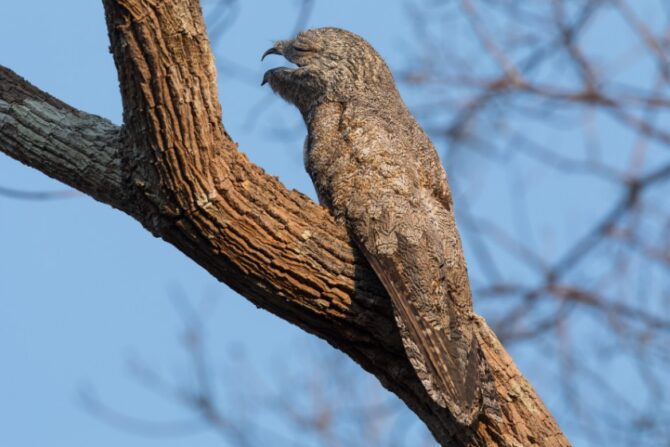
- Scientific name: Phyllaemulor bracteatus
- Length: 8.3 – 9.8 inches
- Weight: 46 grams – 58 grams
- Wingspan: 27.6 inches – 31.7 inches
- Identifying Features: Deep orange-red with large white spots: the color is paler on the throat, spots on the belly have a thin black border, and the tail has darker bars.
- Where found: Brazil, Colombia, Ecuador, French Guiana, Peru, and Venezuela
- Conservation Status: Least Concern
The cranky and eccentric feature of these bird species is that the Potoos’ mirrors a dead leaf which makes it very tough to spot while it is roosting in a tree.
It has a bulbous yellow eye and a distinctive wide mouth, making them look animated.
The Potoo, which looks like a character from a cartoon, comes from a lineage of geriatric birds that are distant relatives to other weird-looking birds like the frogmouth and nightjar.
However, one exception is the Rufous Potoo has a few distinctive qualities.
For instance, the bird has camouflaging abilities and can blend in with dead leaves, bushes, and trees to disguise itself from predators.
4. Ribbon-tailed Astrapia
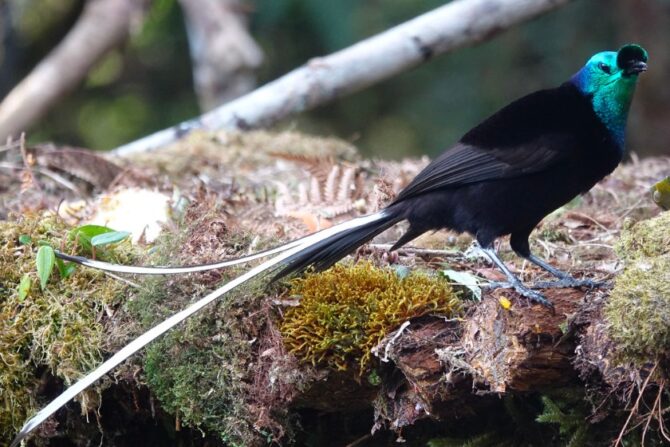
- Scientific name: Astrapia mayeri
- Length: 32cm (excluding the tail, which could be 8 – 15 inches)
- Weight: 134 grams – 164 grams
- Identifying Features: The Adult male has a jet-back head with an intense sheen of metallic green to purple, upper parts black with an olive-green sheen, and a tail with long, narrow white central feathers. Adult females, duller blackish-brown, and tail feathers have white streaks running down their lengths.
- Where found: Papua New Guinea
- Conservation Status: Near-threatened
What makes this bird bizarre? Just take a look at its tail!
You get this strange bird-of-paradise: a bird about one foot long, with flamboyant green-and-blue plumage around its head and a three-foot ornamental tail.
The longest tail-to-body ratio amongst birds is exclusive to males.
Like most male birds, the tails are a way to impress female birds in other to mate with them, but in a funny and bizarre twist, the males are known to get caught up on their own tails.
5. Helmeted Hornbill

- Scientific name: Rhinoplax vigil
- Length: 43 inches – 47 inches
- Weight: 3.1 kg
- Wingspan: 35.4 inches
- Identifying Features: Blackish plumage, belly, and legs are white; the tail is white with a black band near the tip of each feather.
- Where found: Malay Peninsula, Sumatra, Borneo, Thailand, and Myanmar
- Conservation Status: Critically endangered
We’ll agree that this large weird bird looks a little like a rooster and toucan hybrid, bringing together odd features like an elongated yellow beak, a massive casque at the top of the head, and a wrinkly throat patch that buttresses its name.
The casque is so long that it makes up to ten percent of the hornbill’s weight.
This species is exclusive only to the Malay Peninsula, Sumatra, Borneo, Thailand, and Myanmar.
Sadly, the bird is a victim of intense poaching, which has pushed the species to near extinction.
This is primarily because the bird is killed for its casques, which are made into carved jewelry and ornaments.
6. Shoebill
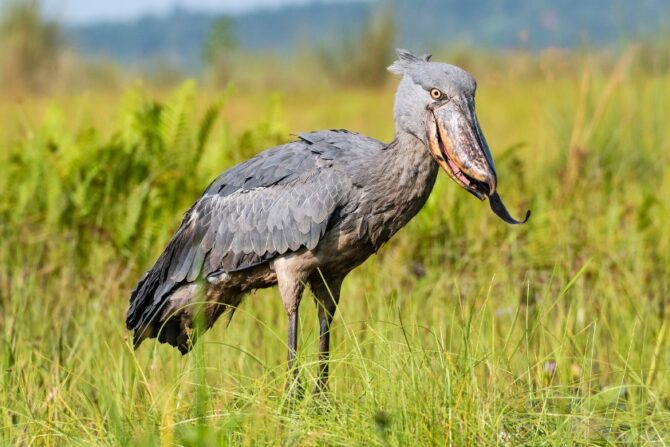
- Scientific name: Balaeniceps rex
- Length: 39 inches – 55 inches
- Height: 43 inches – 55 inches
- Weight: 4 – 7 kg
- Wingspan: 7 feet, 7 inches – 8 feet, 6 inches
- Identifying Features: Large, somewhat frightful plumage, slaty blue-grey overall with a darker grey head.
- Where found: East Africa
- Conservation Status: Vulnerable
Also known as whale-headed stork, whalebill, or shoe-billed stork, the shoebill is endowed with one of the most peculiar and strangest beaks in the bird kingdom.
What makes the deftly named shoebill so distinctive is its one-foot-long bill that reminds you of a dutch clog.
The muscles of the jaw and the hardened bill help it feast primarily on fish and occasionally on amphibians, reptiles, and even smaller birds.
7. Long-Wattled Umbrellabird

- Scientific name: Cephalopterus penduliger
- Length: 15.7 inches – 16.5 inches
- Weight: 320 grams – 570 grams
- Wingspan: 26 inches – 28 inches
- Identifying Features: Males usually have large throat wattle of feathers, with generally black-colored shafts in their feathers, while females and juveniles have smaller or no wattle.
- Where found: Western Colombia and Ecuador
- Conservation Status: Vulnerable
The Long-wattled Umbrellabird is found exclusively on the coast of Colombia and Ecuador.
This strange bird has a crest on the top of its head that resembles that of Elvis (pun intended).
The males have long throat wattle that is flamboyant and used to attract mates.
This exceptional and bizarre-looking species is considered vulnerable, though ongoing conservation efforts can hopefully keep it alive and kicking.
8. Vogelkop Superb Bird of Paradise
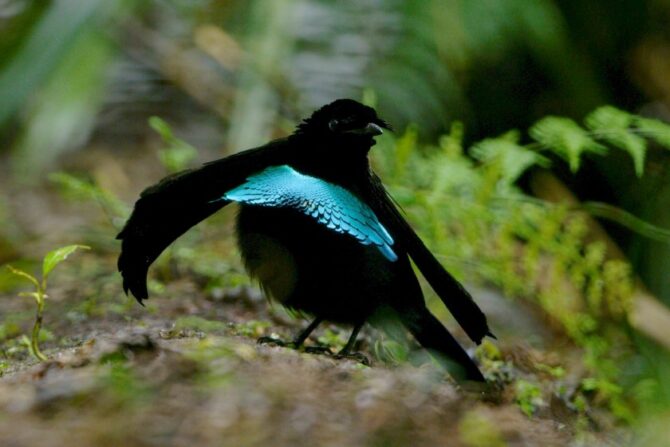
- Scientific name: Lophorina niedda
- Length: 10.2 inches
- Weight: 60 – 105 grams
- Wingspan: 22 inches
- Identifying Features: Males are mostly black, with the rest of their plumage multicolored with a green crown, blue-green breast cover, and a long raised, velvety-black cape flowing down the back. The female is reddish-brown, with a brownish-barred buff on the underside. The young bear a resemblance to the females.
- Where found: Western New Guinea and Indonesia
- Conservation Status: Least Concern
Also known as the crescent-caped lophorina, the vogelkop is a unique bird, having one of the blackest colorings on earth.
It shows off illustrious blue markings that incarnate what looks like a caricature face when trying to seduce a female.
To attract the female, the male Vogelkop will spread its plumage, which resembles a deep black fan with a blue color in the middle, and then performs an elaborate dance that involves unique side-to-side motions, gliding lightly with the plumage.
9. California Condor
- Scientific name: Gymnogyps californianus
- Length: 43 inches – 55 inches
- Weight: 9 kg – 12 kg
- Wingspan: 9.8 feet
- Identifying Features: Uniform black, bands of the white underside of the wings, gray legs, and feet, ivory-colored bill, a frill of black feathers around the base of the neck, little or no feather on the head.
- Where found: California
- Conservation Status: Critically Endangered
A mature California condor possesses a peculiar orange-red to pink-purple head and neck, which is bald, making the bird look as if it is wearing a jacket.
Its appearance evokes your memory of Hellboy. This bird makes use of its weird bald head to alter its skin color in response to its environment, using visual language like the octopus, an example of convergent evolution.
Once extinct in the wild, the largest North American bird has since precariously rebounded, thanks to serious conservation efforts.
10. Papuan frogmouth
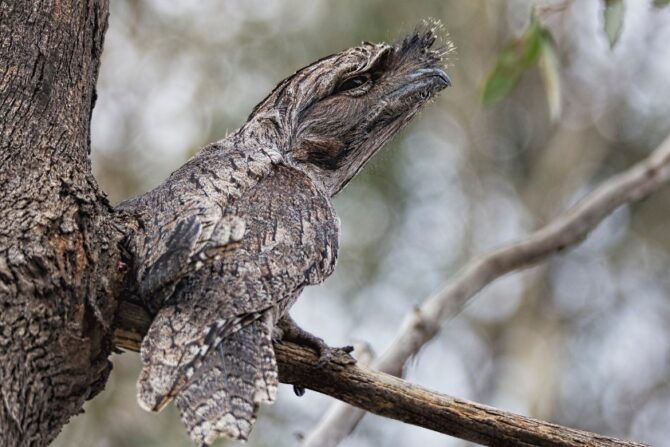
- Scientific name: Podargus papuensis
- Length: 20 inches – 24 inches
- Weight: 290 grams – 570 grams
- Wingspan: 2 feet – 3 feet
- Identifying Features: Bulbous bill, red eye, cream eyebrow, long tail, and dark wings.
- Where found: Aru Islands, New Guinea, and Cape York Peninsula
- Conservation Status: Least Concern
The simplest way to distinguish a Papuan Frogmouth is its scary large red eyes and bulbous bill.
The frogmouth resembles a frowzy, gigantic version of their petite relatives. They are the closest relatives of the owls.
All twelve species of frogmouth are some of the weirdest birds in the world. Despite being related to swifts and agile swallows, frogmouths are less aerodynamic and do not engage in an acrobatic flight to catch insects.
Instead, they prefer to remain stationary and wait for insects or other small prey to come to them.
Frequently Asked Questions
What is the scariest bird?
The world’s scariest bird is usually considered to be the cassowary, at least when it concerns humans, although emus and ostriches can also be dangerous.
What is the weirdest-looking bird in the world?
The species that tops the list of weirdest birds in the world is none other than New Zealand’s Kakapo parrot. It was once thought to have gone into extinction. The kakapo is also the only flightless parrot in the world.
What is the rarest bird in the world?
The rarest birds in the world include the South Philippine dwarf kingfisher found in the Philippines, photographed for the first time in 130 years, and the New Zealand rock wren, endemic to the South Island of New Zealand. The population of the New Zealand rock wren decreased dramatically, almost 50%, between 1985-2005. The remaining survivors were moved to the Southern Island for conservation.
What is a ghost bird?
The ghost bird, or the great Potoo, is a nocturnal bird that resembles an owl but does not belong to the same family. It feasts on small vertebrates and large insects.
Wrap Up
Our bizarre and strange feathery friends differ in terms of species and how they live their lives.
Some of these weird birds are almost going into extinction because of poachers and no proper conservative measures, while some are flourishing impressively.
However, the most significant factor that influences the survival or elimination of these birds is human activities.
So it is paramount that our activities do not negatively affect them.
Next up…
- Biggest Birds In The World
- Purple Birds List
- Beautiful Birds With Mohawks
- Ugliest Animals In The World
